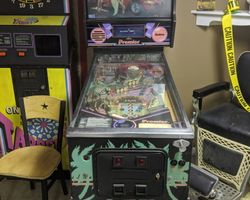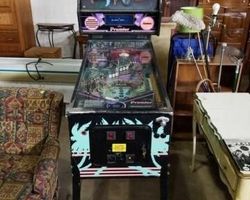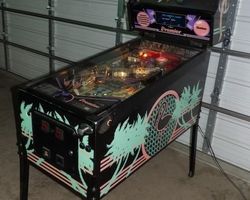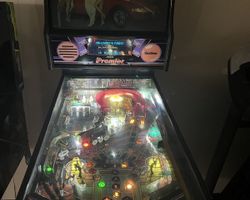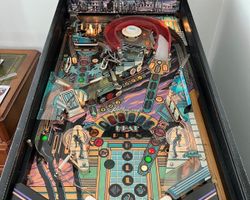Hollywood Heat
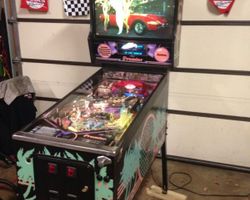
Average Prices: USD $200 to $900
Produced: June, 1986
Production Run: 3,400 units
Machine Type: Solid State Electronic
MPU: Gottlieb System 80B
Players: 4
Design by: John Trudeau
Art by: Larry Day, Don Marshall
The mid-1980s marked a distinctive period in pinball, a time when manufacturers sought to blend evolving electronic capabilities with compelling themes. Among the machines released during this era, D. Gottlieb & Co., operating under its Premier Technology brand, introduced a game that encapsulated the vibrant aesthetic and soundscape of its time: Hollywood Heat. Released in June 1986, this solid-state electronic (SS) pinball machine, model number 703, saw a production run of 3,400 units, making it a moderately produced title for the era.
The inspiration for Hollywood Heat was deeply rooted in the popular culture of the 1980s. While not a licensed product, its thematic essence – a high-energy blend of police drama, neon-soaked nights, and a distinctive 80s vibe – drew directly from the immensely popular television show "Miami Vice." Pinball designer John Trudeau, responsible for the game’s core mechanics, confirmed this direct influence, aiming to capture the show's spirit without infringing on intellectual property. The creative team behind Hollywood Heat was a collaborative effort: John Trudeau handled the game design, Ken Hale was responsible for the music and sound, and John Buras programmed the software. Visually, the machine was a product of two distinct artists: Larry Day designed the detailed playfield and cabinet artwork, while Don Marshall crafted the photographic translite. The original concept for the machine originated from Jeff Walker of Premier’s Marketing Department, who even appeared in the game’s promotional flyer. An interesting detail about the translite is its portrayal of Ocean Drive at 13th Street in Miami Beach, Florida. During the photo shoot, one of the hotel’s neon lights was out, requiring a subtle retouch in the final image to appear functional, though only the two working lights are reflected in the car’s hood on the translite. Hollywood Heat also holds a unique place in pinball history, having been advertised as the first game to utilize 8-digit scoring, a sign of the increasing complexity in game mechanics and score tracking. The soundboard utilized in Hollywood Heat was a transitional component, bridging Gottlieb’s System 80 era with the improved audio capabilities that would later define their System 3 machines.
Signature Features and Design
Hollywood Heat distinguishes itself through several unique design choices that enhance its gameplay and reinforce its distinctive aesthetic. The most immediately recognizable of these is the "captive bumper" mechanism. Unlike typical pop bumpers directly integrated into the main playfield, Hollywood Heat features a single pop bumper that is physically isolated. This bumper can only be activated by a captive ball, which players shoot into a dedicated upper-left area. This creates a distinct mini-game within the game, as the captive ball rattles around, hitting the isolated bumper and generating points and effects, a genuinely novel approach at the time.
Beyond this innovative mechanism, the game incorporates "remote trip" drop targets. During multiball play, dropping a target on one of the two 3-bank drop target sets causes a corresponding target to drop on the other set. This intelligent programming adds a strategic layer to multiball, as players must consider how their shots affect both sets of targets simultaneously. The "in-sync" flashing inserts on the playfield provide visual feedback, responding dynamically to gameplay events and contributing to the machine’s energetic atmosphere. The overall design leans heavily into the 80s aesthetic, with neon colors, palm trees, and the prominent photographic translite. While the artwork, particularly the backglass, has received mixed reactions, often described as "cheesy," it is undeniably evocative of its era, becoming an integral part of the machine's charm for many enthusiasts.
Playfield and Mechanics
The playfield of Hollywood Heat presents an asymmetric and somewhat unconventional layout, designed to offer a varied shot experience. It features four flippers, providing diverse control options and shot angles. Two ramps are prominent, including a "Hot Shot" ramp, encouraging players to aim for flowing shots. The playfield integrates seven standup targets and two sets of 3-bank drop targets, for a total of six, which are central to gameplay progression and the unique "remote trip" feature during multiball. Two kick-out holes provide distinct ball returns, often setting up critical shots.
The central feature, the captive ball mechanism, is positioned in the upper left of the playfield, drawing player focus to this unique interactive element. A single rollunder adds to the shot variety. The design philosophy behind this layout emphasizes a good number of distinct shots, aiming to prevent quick repetition and maintain player engagement over longer sessions. The upper-left area, including the captive ball and a mini-playfield, feels well-integrated rather than an afterthought, contributing meaningfully to the game's flow. Larry Day’s artwork for the playfield and cabinet perfectly complements the 80s theme, utilizing a vibrant palette that, despite some finding it polarizing, captures the essence of the era’s pop culture. The lighting, while sometimes noted as dark by some players even with modern LED upgrades, contributes to the neon-drenched atmosphere envisioned by the designers.
Gameplay Dynamics
Hollywood Heat's gameplay is centered around its exciting 3-ball multiball, which is considered relatively easy to achieve and serves as the primary avenue for high scores. Players lock balls to initiate multiball, leading to a frantic, high-scoring period. The "remote trip" and "memory" drop targets during multiball add a layer of strategy, requiring players to understand how dropping one target can affect the state of others, encouraging thoughtful shot selection amidst the chaos.
Beyond multiball, the game features various objectives tied to its ramps, targets, and the captive ball mechanism. While some consider the overall rule set to be less complex than later machines, Hollywood Heat offers enough depth to keep players engaged, particularly through the pursuit of building bonus multipliers. The sound design, crafted by Ken Hale, is a highlight. Its digitized 80s soundtrack and sound effects are widely praised for being catchy, appropriate for the theme, and significantly contributing to the game's immersive quality. Although the game lacks custom speech, a feature becoming more common in later machines, the music and sound effects effectively convey the high-octane police chase theme. The gameplay often boils down to a balance of aiming for multiball initiation and skillfully managing the ball to capitalize on the various scoring opportunities presented by its unique playfield features, demanding precise ball control from the player to navigate the quick drains that some have associated with its layout.
Reception and Legacy
Hollywood Heat elicits a mixed yet largely positive response within the pinball community. While some players find aspects of it to be simple or even "boring," a significant portion appreciates its unique characteristics and considers it an underrated game, particularly given its market value. It is frequently referred to as a "sleeper" or a machine that offers excellent "bang for your buck."
Among its strengths, the captive bumper mechanism consistently receives praise for its originality. The intelligent programming behind the "in-sync" flashing inserts and the memory drop targets during multiball are also frequently cited as clever design choices that enhance the playing experience. Multiball itself is a highlight, generally regarded as accessible and exciting, providing a satisfying, high-energy payoff. The distinct 80s soundtrack is widely celebrated as one of the machine’s most compelling features, contributing significantly to its thematic appeal and providing a strong sense of nostalgia for many. The playfield layout, while unconventional, is appreciated for its asymmetric design, offering a variety of shots and preventing a sense of repetition. The mini-playfield on the upper left is viewed as an integral part of the game’s design rather than an add-on. The machine’s strong 80s theme, evoking a "Miami Vice" feel, is a major draw, and even those who initially find the artwork somewhat "cheesy" often come to appreciate its distinctive charm.
However, Hollywood Heat is not without its criticisms. The most frequent complaint centers on the artwork, particularly the photographic translite and backglass, which many describe as "ugly" or "horrendous," often leading owners to seek custom replacements. For some players, the game's rule set can feel shallow beyond the pursuit of multiball, potentially leading to quick boredom. A few critiques also point to potentially weak flippers or the need for very precise ball control, as the playfield layout can sometimes lead to quick drains. Minor points include a lengthy bonus countdown on the final ball and the absence of custom voice call-outs.
Despite these criticisms, Hollywood Heat's legacy is that of a solid Gottlieb System 80B machine from the Premier Technology era that carved out its own niche. It stands as a testament to the creative design efforts of John Trudeau and his team, particularly with its innovative captive bumper and multiball drop target mechanics. Its distinctive 80s theme ensures its place as a time capsule, a machine that perfectly encapsulates the pop culture sensibilities of its release year. Often recommended as an excellent entry-level or "filler" machine for collections due to its value and engaging gameplay, Hollywood Heat remains a memorable example of Gottlieb's output in the mid-1980s, showcasing how original features and a strong thematic identity could define a pinball experience.
Sponsored Links
 Ebay Listings
Ebay Listings
 Auction Results
Auction Results
| Cost | Location | Date |
|---|---|---|
| EUR €2,850 |  Baden-Württemberg, Germany Baden-Württemberg, Germany |
25 December, 2024 |
| USD $1,500 |  Arizona, United States Arizona, United States |
19 June, 2024 |
| GBP £1,250 |  Chertsey, United Kingdom Chertsey, United Kingdom |
25 July, 2023 |
| USD $2,400 |  Illinois, United States Illinois, United States |
17 April, 2023 |
| USD $1,201 |  Illinois, United States Illinois, United States |
26 October, 2022 |
| USD $1,600 |  New York, United States New York, United States |
21 October, 2022 |
| USD $1,225 |  Pennsylvania, United States Pennsylvania, United States |
18 August, 2022 |
| USD $500 |  Indiana, United States Indiana, United States |
06 September, 2021 |
| USD $500 |  Illinois, United States Illinois, United States |
28 March, 2021 |
| USD $1,000 |  United States United States |
17 September, 2020 |


Private Policy · Search Website · Contact Us
As an eBay Partner, we may earn a commission from qualifying purchases made through links on this site, at no additional cost to you.
All trademarks and copyrighted materials remain property of their respective owners. All other content copyright 2007 - 2025 Pinpedia.

